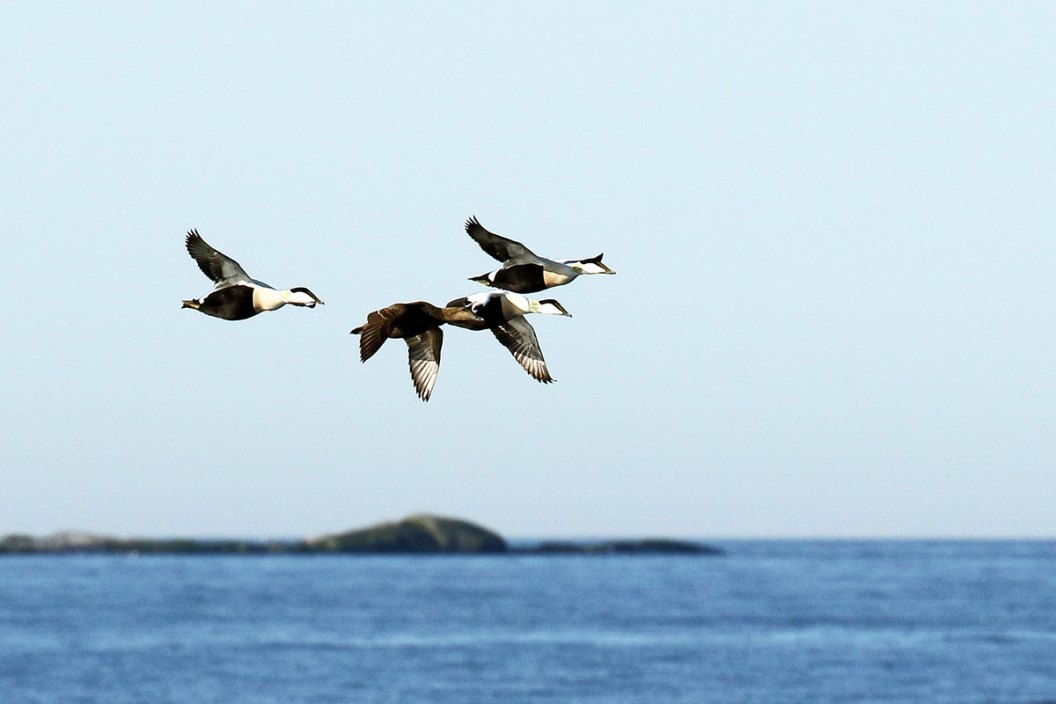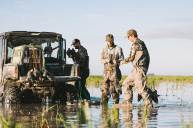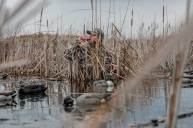Here's a good primer if you're thinking about duck hunting in saltwater.
You may consider the idea of duck hunting in saltwater as odd, especially if you've never lived in a coastal area. Boating out to deep water and shooting some diving ducks on the open ocean may seem foreign.
In reality, there are entire books written on the locations and tactics for hunting saltwater, be it open oceans or bays, marshes, or estuaries. Truth be told, not all saltwater duck hunting requires a boat, and sometimes it can be much like hunting the hidden inland ponds and fields more of us waterfowlers are used to.
There are extra gear care steps you'll want to take, and more attention you'll need to pay to things like wind direction, tide charts, and coastal weather conditions. If you've got a duck hunting dog, odds are you'll really be able to see their talents shine in a coastal, saltwater hunting scenario. For those who have hunted the deep saltwater marshes in reeds that are twice as tall as the average human, we understand how much a good solid retrieving gun dog means to this type of hunt.
Ultimately, a saltwater hunt for ducks can produce some of the best opportunities to limit out (and do so quickly) all season. That is, if you play your cards right. The situation is nicely set up, it's just a matter of putting together the equation that equals bird hunting success.
In fact, many of the most productive coastal duck hunting areas happen to fall on public hunting grounds, even some that are placed very near to waterfowl refuges that hold thousands of birds.
If they're headed the right direction, and you're there to meet them when they arrive, a saltwater duck hunt could be the best you've ever had.
Hunting Coastal Sloughs and Marshes
Many times when scouting these pristine duck grabbing locations, a waterfowl hunter will see puddle ducks (or dabbling ducks) by the hundreds. They're often in a single area, sticking close to their kind and
Of course, you'll want to look sharp, because there won't be only dabbling ducks there. Mallards, black ducks, pintails, and even widgeon tend to congregate together at times during the fall stopover along the coasts, but the diving ducks are there too, and probably have been for a good while.
As we discussed earlier, a good gun dog is an imperative in the marsh. A finished dog that can be directed to a downed bird in the thick, sky-high cattails is a partner that is worth his or her weight in gold. Labrador retrievers are a key dog breed for these types of hunts, as it is what they were bred for, but anyone who has hunted with a Chesapeake Bay retriever knows that they will relentlessly hunt an injured or downed bird until they find it, or until you call them off.
As with any duck hunt, conditions can vastly dictate your success rate. "Blue Bird" or sunny, blue skies are generally great conditions if you're going to the beach for the day, but not so much for duck hunting. Heavy breezes are best for keeping ducks closer to shorelines. In those situations, it's easier to decoy ducks that are looking to settle in and limit the stress of flying in difficult winds.
First light is still the order of the day for most waterfowl hunting, and the biggest reason why duck hunters get up long before the sunrise. This is not to say that certain daylight hours are useless to waterfowlers, since many veteran duck hunters rely on birds that are setting out for their second round of morning feeding. But most commonly it's the early risers that see the best odds of success.
In the big scheme of things, duck hunting in saltwater or brackish areas is not too different from doing so in freshwater.
Open Water Hunting
Open water duck hunting is where the rubber meets the road for many seasoned waterfowl hunters. Here is where you will find out just how much work it takes to prepare your gear, reach the coast, set up, and get to some serious wingshooting.
Those who have done this for a lifetime will tell you that the labor is worth it. Getting onto the open water may have many pitfalls, but it also has the greatest rewards.
Safety should be the highest concern for hunting in this style. Boats should be inspected regularly, personal floatation devices should be worn at all times, and emergency plans should be made ahead of time.
Since open water duck hunting can be one of the most dangerous hunts you can undertake, this is a great opportunity to consider relying on a professional guide or outfitter that has years of experience hunting the saltwater coasts. These are folks who probably grew up and spent their entire lives putting on their own waterfowl hunting expeditions and now live to share those exploits with others.
Many times these types of hunts will take you into a river system, possibly in brackish water, where there are scores of birds using the open water as feeding and loafing grounds. These areas are ripe with the opportunity to fill your bag limit.
Experienced guides will already have a plan for everything including where to set up, what to bring, gear and food for their clients, extra cold weather apparel, shelter when needed, and most importantly, an emergency plan for when conditions turn nasty in a heartbeat.
This is all above and beyond duck hunting on the shoreline, which is virtually impossible in some conditions. Even at that, high tides and rough water can swamp a hunter in waders trying to set or reset decoys, and even take a tole on any good gun dog.
Knowing what weather and tidal conditions to avoid can be the key to a safe hunt, and the pros are the ones that have seen it all.
Saltwater Decoy Spreads
If you have the resources, setting up with a big block of decoys—we're talking one hundred or more—can be the difference between having shots to take or watching birds skirt your set. You'll want your spread to have the drawing power needed to suck them in. In other words, even if you're not going to see many birds, you'll want those that you do see to look at a spread that stands out.
In these cases it is always a smart idea to try and match the ducks with decoy numbers and species. A good rule of thumb is to keep the largest main group of your decoys as one species, and to use a mixed bag of other decoys in smaller numbers. Consider adding pairs or triplets on the outskirts of the main block.
Just as waterfowlers have been taught for years, leave a landing hole in front of the blind area. You can enhance it with a pair of dekes sitting to one side as a lure for birds flying near; it makes it look like a couple of birds that just landed.
Probably the number one decoy spread for diving ducks anywhere is the fishhook or J-hook spread, with the long portion of the hook going away from your blind. Hunters have been using this spread to entice waterfowl for many years with a great deal of success, and it's simple to use.
The bend of the "J" is always set just upwind of the blind, or, at times, to a right angle from it, usually about 20 yards. Inside the bend, use up to 50 individual and line-rigged bluebill decoys (or diving duck dekes of your choice, particularly drakes) to simulate a large group feeding. Passing birds see the predominantly white rigs, follow the outside of the tail upwind, and visually focus in on the feeding frenzy.
The "X" decoy spread is also a particularly good way to get the attention of sea ducks since it gives ample room to land for birds in areas where the wind and surf leaves things choppy and unsettled. Conditions like these cause ducks to quickly identify a place to land and rest once committed, and an X shape provides four such areas.
The center or crossing point of the X is where the hunters sit, with plenty of chances to get a shot off.
This is not so much wind direction related, as it is making a larger area of possible landing spots for your quarry as birds can sit in any crux of the X while still giving the waterfowlers a shot.
Differentiating Sea Ducks and Other Diving Ducks

Puddle ducks are also known as dabbling ducks, but not all diving duck species are known only as divers; they are sometimes referred to as sea ducks. As the name implies, sea ducks are much more adapted to life on the ocean, with most breeds spending a considerable portion of the year along the coasts after breeding in areas such as the Canadian Arctic and Alaska. These species have special adaptations for life in colder, saltwater environments.
Honestly, anyone who has hunted waterfowl long enough has seen puddle ducks dive as well, especially if they are injured by a hunter, but it is certainly not the rule.
By most definitions, here's how they're grouped together:
Divers
- Masked Duck
- Ruddy Duck
- Greater Scaup
- Lesser Scaup
- Ring-necked Duck
- Redhead
- Canvasback
Sea Ducks
- Mergansers
- Bufflehead
- Goldeneye
- Oldsquaw
- Harlequin Duck
- Scoters
- Eiders
The Last Word
Sportsmen looking for these great big water honey holes shouldn't need to be reminded that these are still migratory birds. Hunters are required to carry a valid hunting license and a federal duck stamp for areas where saltwater duck hunting is legal.
These aren't your grandaddy's jump shooting potholes, but much more vast. They introduce dangerous situations where the weather can turn on a hunter in the blink of an eye. It can be enough to turn a prime hunting spot into a life changing experience, and not for the better.
Saltwater hunting opportunities may be some of the best that there are in terms of quality and quantity of game birds, but it should never be at the risk of personal safety. Anyone who has spent some time out on the open ocean doing some saltwater fishing will tell you that the sea is not an area to be trifled with, but always respected.
But at the same time, if you do it safely enough times, saltwater duck hunting can turn into a productive and enjoyable way to do it.
Looking for a little more or even hot lunch for your hunting blind? Follow my webpage, or on Facebook and YouTube.
NEXT: MAN FINDS LAKE LITTERED WITH FROZEN CARP
WATCH




